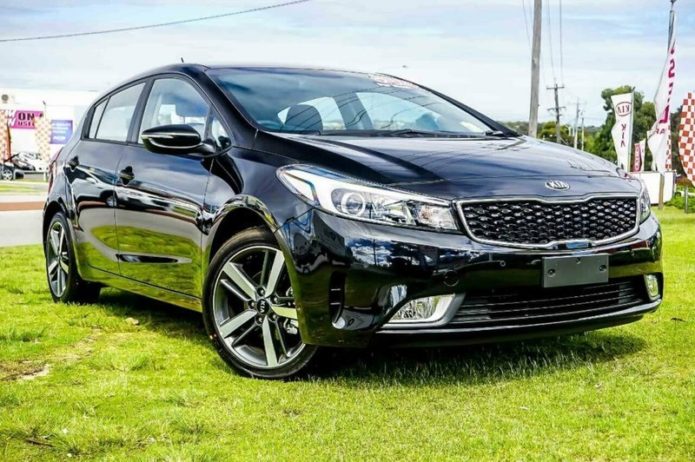Kia has just launched its new Cerato sedan in Australia. Here are six reasons why it’s better than its small-car competitors

The Cerato, and indeed many Kia models, have played second fiddle to their rivals for long enough. Now, Kia has thrown everything it has at the new Cerato to make sure it’s at the top of its game.
Here we take a look at several key areas of the new 2018 BD-series Kia Cerato to see what makes it better than the competition.
Better ride and handling than a Toyota Corolla

Kia invests heavily in tuning its ride and handling to suit Australian conditions, and the Cerato is no exception.
Working with former Toyota chassis engineer Graeme Gambold, Kia engineers in Australia and South Korea test and tune myriad bushings, dampers and springs to ensure safe and predictable handling irrespective of road conditions.
Ride comfort and quietness is also factored into the equation with a result we reckon places the Kia Cerato on par with the cars it was benchmarked against. In case you’re wondering, they are the Honda Civic, Hyundai i30, Ford Focus and Volkswagen Golf. Not a Toyota Corolla in sight…
Better cabin noise levels than a Mazda3

Even in smaller, less expensive cars there’s an expectation that occupants should be able to maintain a conversation at highway speeds irrespective of the road surface.
And while some of the Cerato’s rivals have struggled time and again to make their cabins quiet (we’re looking at you, Mazda3) Kia has gone back to the drawing board with its new Cerato, changing engine and sub-frame mounts, reshaping the body, fitting thicker door seals and adding insulation material to ensure a far quieter ride.
The results bring cabin acoustics down to (according to Kia) an ultra-low 64dB, which makes the Cerato as quiet as the best in its class.
Better standard safety tech than a Mitsubishi Lancer

It’s hard to believe that in 2018 there are some manufacturers that don’t offer, or charge a premium for, potentially life-saving safety technology like autonomous emergency braking (AEB).
Now standard on all model grades of Kia Cerato, AEB recognises rapid closing speeds of objects in front and applies the brakes to avoid, or reduce the severity of, a potential impact.
High-grade Cerato Sport+ models take the technology one step further, recognising cyclists and pedestrians with Kia’s Fusion II AEB system. This is offered optionally on lower trim grades for just $1000 more.
Of the big-name small-car competitors currently available, only the Mitsubishi Lancer fails to offer AEB.
More cabin and cargo space than a Ford Focus

Small cars aren’t really ‘small’ any more. In fact, the new Kia Cerato sedan is almost as big as the original Kia Optima, and only 66mm shorter in length than the first Holden Commodore!
For this generation we find improvements in cabin space totalling 4mm extra headroom, 3mm more legroom and 10mm additional shoulder-room, as well as additional soft-touch materials and ergonomic adjustments aimed at improving comfort at the wheel.
Cargo space also jumps a substantial 20 litres to total a whopping 502. Compared to its big-selling small sedan rivals, the Kia Cerato now offers more cargo space than Ford’s Focus (+127 litres), Mazda’s 3 (+83 litres) and Toyota’s Corolla (+32 litres).
Better connectivity than a Mazda 3

In 2018, connectivity is king. Irrespective of vehicle size and price there are givens when it comes to infotainment – chiefly that smartphone connectivity includes the ability to interact with more than just your music and do more than just make phone calls.
That’s why most manufactures now offer Apple CarPlay and Android Auto connectivity in even their least expensive models. Kia now includes the technology across the Cerato range, including the base-grade Cerato S.
Compared to its mainstream rivals, it’s really only the Mazda3 that still fails to offer detailed smartphone integration – a shame considering the entry price is higher than the Kia Cerato’s.
Better after-sales support than all

Kia offers a seven-year/unlimited-kilometre warranty, roadside assistance and capped-price servicing plan across its entire passenger car range, which sees the Cerato top all of its small-car competitors.
Since May 1 Ford has offered a five-year/100,000km warranty, matching Mitsubishi, but Holden and Toyota still provide only three years or 100,000km. Mazda, Subaru and Volkswagen offer a three-year/unlimited-kilometre arrangement, while Honda recently matched Citroen, Hyundai, Peugeot and Renault with a five-year/unlimited-km deal.
As is the case with any warranty and capped-price service plan, we strongly recommend reading the fine print.
But throw in an unchanged starting price of $19,990 drive-away and the new Kia Cerato sedan offers stand-out value in its class, and we expect the all-new Cerato hatch will follow suit when it arrives later this year.
(motoring.com.au, http://bit.ly/2JHBgeJ)


